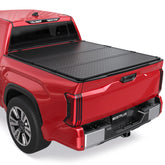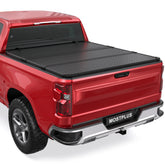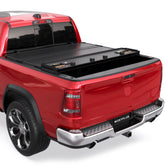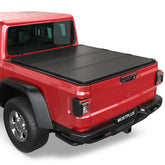How do I transport my bike in my car?
You're going on vacation or for the weekend and want to ride your bike right away? You've got a great bike ride in mind, but it's a long way from home. So you want to drive to the starting point? There are a number of ways you can transport your bike in your car. You can put it in the trunk, on the roof, on a rear rack, or on a trailer. In this article, we'll look at how to transport your bike in a car using each of these methods.
On the roof rack
The first solution we suggest is to mount your bike on the roof of your car. This requires a bit of equipment: first, you need to buy roof racks, also known as side bars, to support the bike carrier. There are models for up to four bikes. This system provides good rear visibility and easy access to the trunk. However, if your bike is electrically assisted, it's not for everyone to be able to lift their bike onto the roof of their car at arm's length. You will also need to consider the overall height of your vehicle and your bike, so that you can anticipate entering parking lots, tunnels, or toll booths that are too low.

This solution can also increase your fuel consumption. Finally, remember to adapt your driving style to your load and to be extra vigilant. In particular, be aware of wind resistance when cornering and be careful when braking.
For the safety of other road users and to reduce fuel consumption, we strongly advise you to remove the bike carrier when you're not using it.
Cons
- Increased wind resistance (watch your speed)
- Increased fuel consumption
- Impact of height restrictions in tunnels, parking lots, etc.
Pros
- Quick and easy installation (universal system)
- Low price
- No impact on rear visibility and trunk access
- Saves space when stored after use
In the trunk of your car
If you decide to put your bike in the trunk of your car, you'll need to remove the wheel before putting the bike in the trunk. Make sure the bike is securely fastened so it won't move while you ride.
This is not the easiest solution as it requires some handling of the bike and you need to make sure that the bike is properly secured so that it doesn't damage your car or injure anyone in the event of an accident. What's more, it only works for one bike or, in a pinch, one adult and one child's bike.

Cons
- Limits space for passengers and luggage.
- Can make the trunk or rear seats dirty.
Pros
- No extra cost.
- Protects against theft or vandalism.
- Protects your bike from the elements.
- Does not block car cameras and radar.
- No additional obstruction to driving or parking.
- Does not affect the vehicle's aerodynamics, so no extra fuel consumption.
Here are four tips for transporting your bike in a car:
- Make sure the bike is clean, especially the chain and drivetrain.
- Put your gear on the smallest chainring and sprocket.
- Use a blanket or something similar to protect both the bike and the car.
- Be sure to secure the bike and wheels so they won't move or slip in the event of an accident or sudden braking. You could be fined for carrying potentially dangerous objects in the car.
For longer trips and more frequent use, it's best to use a trunk bike rack. You'll be able to carry up to 3 adult-sized bikes for the entire trip! These are specially designed to hold your bikes securely in place.
There are 2 types of trunk bike racks: suspended and platform. Suspended models are ideal for bikes with thin frames. They don't provide optimal support for VTC-type bikes with thicker frames or non-standard shapes. Bike racks with a platform are suitable for all bikes and will hold your bikes perfectly. The platform can be folded away to save space and make storage easier when not carrying bikes.
For installation, the straps and adjustment knobs allow you to adapt to any model of car, and we advise you to take the time to properly install your bike carrier in the trunk of your car. The first assembly will probably take longer than expected, as the instructions are sometimes a bit difficult to decipher... Ah, those instructions!
Finally, depending on the model, your license plate and lights may be covered by the bikes, so you'll need to add a plate and light support adapter.
Cons
- Limited rear visibility and trunk access
- Longer installation time
- For hanging models, not suitable for bikes with thick frames or non-standard shapes
Pros
- Securely transports up to 3 bikes
- The mounting system can be adjusted to fit any vehicle with adjustable straps and tightening knobs
- Limited increase in fuel consumption
Hitch-Mounted Bike Carrier
The most expensive option requires your car to be equipped with a tow bar. However, if you often travel with other cyclists, it's the safest and most practical way to transport multiple bikes in your car.

Cons
- This is the most expensive option.
- The hitch is rather heavy and bulky, and therefore not as easy to store as the others.
- Incompatible with vehicles that do not have a ball hitch.
- Requires more parking space.
- Blocks some cameras and radars.
- Exposes the bike to the elements and rear-end collisions.
Pros
- The bike is secure while you're riding and better protected against theft.
- Bikes are easy to install and secure.
- No obstruction to driving.
- No risk of damaging the car or bike(s).
- You keep access to the trunk, at least with most hitches.
- Low fuel consumption, much lower than other types of bike carriers.
What's the best way to transport my bike?
Do I need a bike rack? If you're traveling alone or with a partner and your car has room for two bikes and luggage, you won't need a bike rack. But in all other cases, you may need one. Which bike rack should you choose? Start by answering these questions:
How often will I use it? And how much am I willing to spend on it? If you plan to ride a lot with friends and more than one cyclist, and you're not on a budget, then a roof rack or hitch will be your best option. These are the most expensive options, but also the safest and most practical. The choice between the two will depend on the number of cyclists on the trips, the car itself, and the space you have to store the bike rack when you're not using it... And, of course, your personal preferences. However, if you don't want to spend too much and you're only going to use it once in a while, then a good trunk or hatchback bike rack will be more than enough.
Finally, if you're using roof racks or any other type of bike carrier, we'd like to remind you to follow safety regulations. And don't forget to remove your bike rack after use, as it can increase fuel consumption by 10-20%.
Featured Products
- $479.99
$499.99- $479.99
- Unit price
- / per
- $549.99
$549.99- $549.99
- Unit price
- / per
- $489.99
- $489.99
- Unit price
- / per
- $469.99
$489.67- $469.99
- Unit price
- / per















